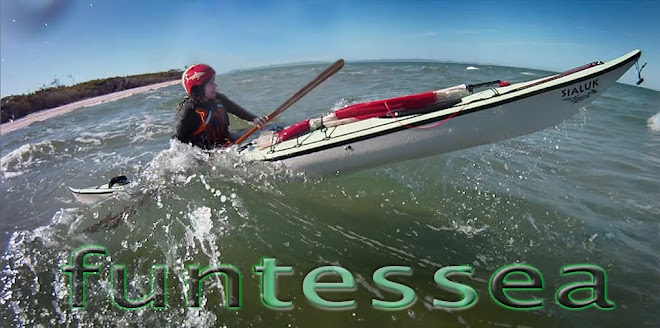Starring: 30knot Melt, Gillian, ‘Little Ripper’ Skipper Rob, Vanilla, Gnarlydog, Adventuretess
Special Appearances: ‘Little Ripper’, 70 black swans, 140ml rain and 30knot winds
 From beneath the brim of my rain soaked hat, I surveyed my companions. Heads bowed into 30knot wind to protect naked eyes from the sting of lashing rain, progress was slow but steady. The force of a sudden stronger onshore gust momentarily surprised me. It was at this moment Vanilla suggested we all kayak roll…
From beneath the brim of my rain soaked hat, I surveyed my companions. Heads bowed into 30knot wind to protect naked eyes from the sting of lashing rain, progress was slow but steady. The force of a sudden stronger onshore gust momentarily surprised me. It was at this moment Vanilla suggested we all kayak roll…24 hours earlier…
The Queensland weather was turned to ‘sauna’ hot.
Our group would be camping remotely on the northern end of Bribie Island. Paddling to meet the others at the launch site, the early morning air was sultry, yet unusually clear and still. Buildings 12km away across the bay were clearly visible.
Kayaks loaded with ultralight camping gear and gourmet food, we made our way north where we would rendezvous with Skipper Rob from ‘Little Ripper’, the only non kayaking member of the group.
Zigzagging around the many sandbanks scattered up the shallow passage, local birdlife was abundant, but the dolphins, turtles and sting rays commonly seen here stayed hidden below us in the cool water.
The humidity as we paddled was unrelenting, causing droplets of sweat to trickle uncomfortably down faces, backs and cleavages.
Halfway to our campsite we located the 'Mothership'.

Landing nearby, views of the distant Glasshouse Mountains were superb. The antics of the resident birds entertained us while we ate lunch.

We continued to enjoy the panorama as we followed the channel toward Lime Pocket, our overnight destination. There are no facilities or drinking water there. Campsites are nestled privately in the bush along the passage. As we passed the Mission Point campground, I was pleased my companions were also interested in remote camping, as the campsites and beach here were overflowing with boats and people.
Reaching Lime Pocket, we quickly set up camp as Skipper Rob arrived and set anchor. Rob promptly cast a fishing line and an amused eye over us as we swam and enjoyed a session rolling the now empty kayaks.


Rolling novice Gillian keenly listened as Melt introduced her to some basic skills. Gill was later rewarded with a hot shower aboard the ‘Mothership’.
Skipper Rob extended his hospitality to the whole group making several trips in the tender collecting some for showers and the rest for refreshments. Recharged, we shared a substantial happy hour on the back deck of ‘Little Ripper’ as the sun set. Once darkness descended, ‘popping’ noises could be heard on the surface of the water surrounded the boat. Efforts were made to try and catch the elusive fish before Rob returned us to shore for dinner.
Evening temperatures were still warm. Gourmet dinners were prepared and eaten quickly, as the mozzies began feasting on us.
During the night the rain came. 140ml of it. Rain. And more rain.

After a night of record breaking rainfall, the downpour eased as dawn arrived.
Launching back into the passage, the weather could not have been more different to the previous day. The volume of rain in the passing showers was incredible. Once again passing Mission Point, the beach and campground were now deserted in stark contrast to the previous afternoon.

Virtually alone on the water we again had only the birdlife for company. Flying above us was an enormous stork whose size was likened to an albatross. Ahead on a large sandbank were elegant shapes that were difficult to identify in the conditions. As we drifted closer, we counted 70 black swans striking poses in the rain.
We returned to the original launch site to farewell 2 group members, while those remaining continued. Incredibly, within minutes of leaving ‘30knot Melt’ behind, a 30 knot squall was upon us. The driving rain pelted our faces and flattened the tops of surrounding waves. It was fantastic and energising to be out there!
Vanilla made the suggestion to roll as the squall momentarily increased. The 3 remaining kayakers rolled as requested, observing the muted silence in those few seconds under water.

On this trip I found that using my Aleut ‘Bling stick by Van’ was easier than the larger bladed euro style paddles I have used in similar conditions on other trips.
The combination of varied conditions, magical wildlife, remote camping and exceptional company made this weekend an absolute cracker – one of my all time favourite overnight trips.

 Taking advantage of the rare water height, we weaved a path over the submerged beach through mangroves and shrubs, inaccessible at other times. Small sandstone cliffs were reminiscent of the coastline in North Queensland, the pink colours a contrast against the surrounding dark foliage.
Taking advantage of the rare water height, we weaved a path over the submerged beach through mangroves and shrubs, inaccessible at other times. Small sandstone cliffs were reminiscent of the coastline in North Queensland, the pink colours a contrast against the surrounding dark foliage. This rainy day exploration had left me with the feeling of a remote experience in my own backyard bay.
This rainy day exploration had left me with the feeling of a remote experience in my own backyard bay.

































![minime balance brace_1 (c)[1]](http://farm5.static.flickr.com/4031/4549753269_15829322e7.jpg)







